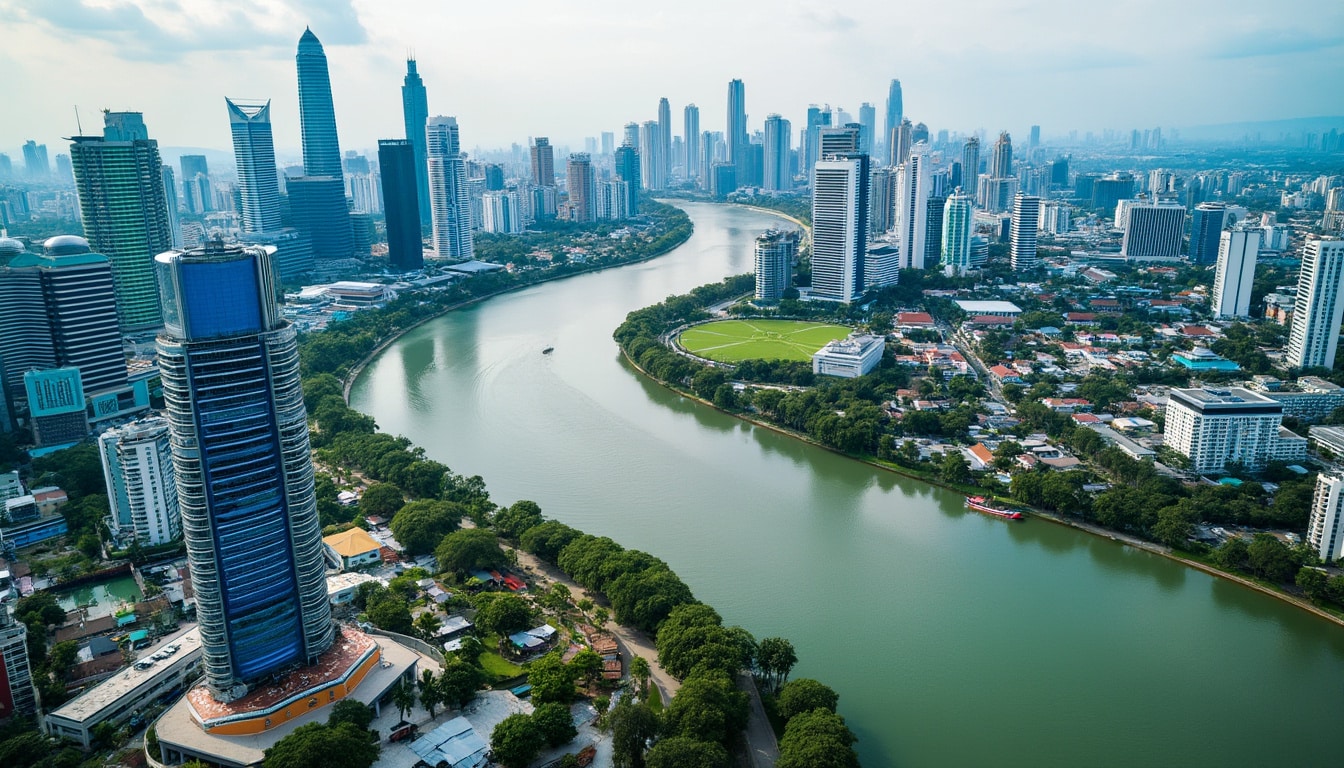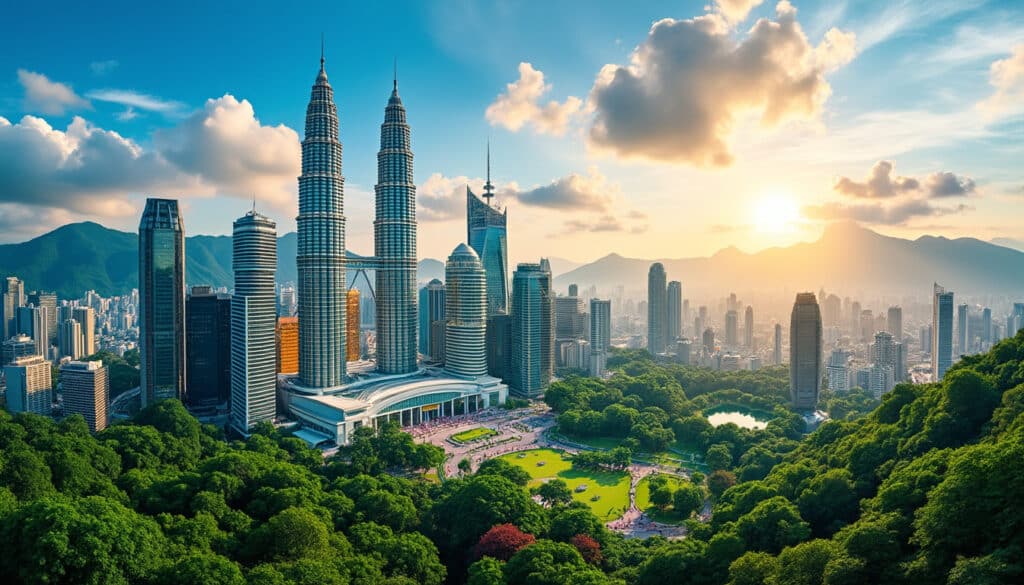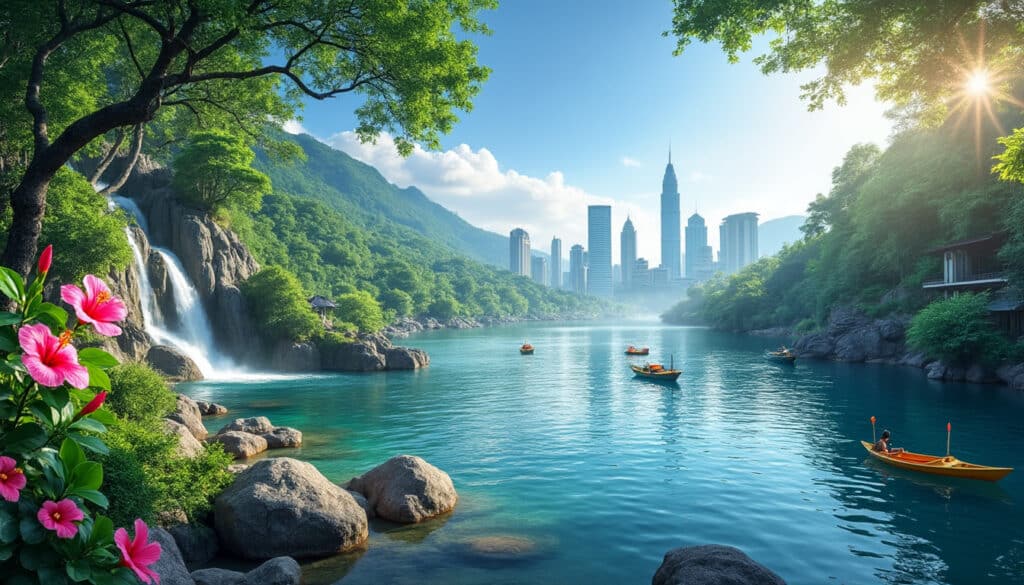Kuala Lumpur, the vibrant heart of Malaysia, is a city where urban landscapes seamlessly blend with nature’s remarkable bounty. Renowned for its eclectic mix of modernity and natural wonders, this city is an epitome of Asian metropolitan charm. As an Eco Explorer in 2025, one is spoilt for choice with its array of urban green spaces, offering a refreshing escape from the city buzz. The city’s geography gifts its inhabitants and visitors the unique opportunity to enjoy tropical trails and Borneo botanicals without wandering far from the cityscape. Every corner of Kuala Lumpur speaks of its sustainability efforts, providing a living example of eco-urban living, aimed at balancing rapid urban development with Mother Nature’s nurturing presence.
Kuala Lumpur’s Unique Urban Geography
Positioned midway along the west coast of Peninsular Malaysia, Kuala Lumpur’s unique geography sets it apart from many other capital cities around the world. Situated at the convergence of the Klang and Gombak Rivers, the city offers more than just a visual wonder; it provides a narrative of historical significance. The city lies approximately 35 kilometers from the coast, forming the central hub of Malaysia’s extensive transportation network, facilitating the seamless movement of people and trade.
The geography of Kuala Lumpur is characterized by a vast valley, known as the Klang Valley, bordered by the impressive Titiwangsa Mountains. These natural barriers not only contribute to the stunning vistas of the city but also play a crucial role in the climatic conditions experienced here. The tropical climate of Kuala Lumpur ensures lush greenery throughout the year, making it a prime destination for those seeking a balance between urban life and nature.
- 📍 Located at the confluence of Klang and Gombak Rivers.
- 🏞️ Bordered by Titiwangsa Mountains, providing stunning natural vistas.
- 🌧️ Experiences a tropical rainforest climate with ample rainfall.
- 🏙️ Central hub for Malaysia’s transportation network.
Kuala Lumpur’s history began as a hub for tin mining in the 19th century, which necessitated efficient transport and communication networks for the transportation of goods. Over time, this infrastructure facilitated the city’s evolution into a bustling metropolis. Today, it stands as both the cultural and financial epicenter of Malaysia, with a population that reflects a tapestry of ethnic diversity. Upper Heritage Heights provide a glimpse at the historical blend of cultures that call Kuala Lumpur home, while initiatives for cityscape sustainability continue to evolve the city into a beacon of urban resilience and eco-consciousness.

The rivers’ presence also highlights Kuala Lumpur’s longstanding socio-economic narrative, heralding from its establishment as a small settlement to its prominent status as a capital city. Interestingly, the water quality and management of these rivers pose continuous challenges, spurring urban studies and conservation efforts in the city. Sustainable initiatives such as the development of rainwater collection systems and the implementation of nature corridors through urban planning illustrate the city’s ongoing commitment to eco-urban living.
The city offers an exciting juxtaposition of natural habitat preservation amidst urban expansion. The balance of cityscape and nature is showcased through numerous nature nests that dot the city, providing sanctuaries for both humans and wildlife. Urban greenscapes are an integral feature, providing ecological services vital to the city’s air and climate management while offering attractive spaces for recreation and community engagement.
Exploring the Natural Wonders Within Kuala Lumpur
Kuala Lumpur’s natural offerings are just as captivating as its urban allure. The city is a gateway to tropical trails and rainforest retreats that draw nature enthusiasts from around the globe. Without ever leaving the city limits, visitors can explore the Borneo Botanicals that embellish numerous parks and gardens. These spaces act as a living showcase of Malaysia’s rich biodiversity, offering both residents and tourists a true escape into nature.
A significant number of Kuala Lumpur’s recreational gardens and forest reserves are designed not only for aesthetic pleasure but also to serve educational purposes. Educational boards, guided tours, and interactive maps enrich the visitor’s understanding of the city’s dedication to preserving its natural treasures. Parks like the Titiwangsa Lake Gardens and the Perdana Botanical Gardens are particularly notable for their extensive flora collections and leisurely trails.
- 🌳 Perdana Botanical Gardens: A green oasis boasting Borneo Botanicals.
- 🌿 Taman Tugu: A Rainforest Retreat with a walking trail through indigenous trees.
- 🐦 KL Bird Park: The world’s largest free-flight walk-in aviary.
- 🐒 Forest Research Institute Malaysia (FRIM): A gateway to rich biodiversity.
One cannot overlook the eco-explorer’s dream destination right within the city’s bounds – the Bukit Nanas Forest Reserve. Also home to the towering KL Tower, it represents the epitome of urban green integration. Trek through luscious foliage, spot local wildlife, and appreciate the serenity of nature contrasting with the surrounding skyscrapers. Active nature projects like these preserve Kuala Lumpur’s ecosystem and foster an eco-conscious approach among its community.
Moreover, city parks and nature reserves are pivotal in supporting Kuala Lumpur’s efforts in climate resilience and urban cooling, factors crucial in tackling the challenges posed by climate change. This commitment is particularly significant in 2025, as environments around the world continue to feel the pressure of global warming. These natural spaces function as critical carbon sinks, offering real benefits in mitigating urban heat and enhancing air quality.
As cityscapes around the world evolve, Kuala Lumpur stands as an exemplary model of how urban environments can coexist harmoniously with nature. Through sustainable development practices, this city continues to push boundaries, proving that progress and preservation need not be mutually exclusive. A trip to this splendid city is incomplete without indulging in its natural landscapes, a testament to the city’s identity as a leading Eco Explorer destination.
Eco-Friendly Attractions and Initiatives
The rise of eco-tourism has seen Kuala Lumpur evolve into a hotspot for environmentally conscious travel. Various attractions across the city include initiatives designed not only to conserve nature but also to educate visitors on the importance of sustainability. From urban food gardens to recycling programs, Kuala Lumpur is dedicated to creating a sustainable future.
The Kuala Lumpur Eco Film Festival, held annually, serves as a platform to raise awareness of environmental issues through the powerful medium of film. Such events are crucial in engaging communities and promoting a culture of sustainability. Educational workshops and interactive sessions provide actionable insights into how individuals can contribute to global environmental efforts.
- 🎥 Kuala Lumpur Eco Film Festival: Promotes eco-conscious awareness through film.
- 🌎 Urban farming projects: Encourages local food production and community engagement.
- 🔄 City-wide recycling campaigns: Aims to reduce waste and promote sustainable practices.
- 🚃 Expansion of public transport: Reduces carbon footprint in line with sustainable goals.
The National Botanical Gardens in Shah Alam, not far from Kuala Lumpur, provides another vital space where individuals can connect with nature. The garden showcases a diverse range of tropical plants and offers various eco-friendly initiatives that visitors can learn from and support. Collaborative programs with scientists and botanists foster deeper insights into the botanical world and conservation efforts.
To support cityscape sustainability, Kuala Lumpur has actively promoted public transport expansion, with new train lines and bus routes making the city more accessible. This not only reduces the individual carbon footprint but also mitigates congestion, contributing to a healthier environment. Connectivity improvements also support local businesses and stimulate eco-tourism, with ease of access enhancing the overall visitor experience to the city.
As Kuala Lumpur strides boldly into the future, the emphasis on green initiatives and embracing eco-friendly innovation signals a commitment to long-term sustainability that other cities may well draw inspiration from. Whether it’s through its expansive green spaces, community-based projects, or innovative policy-making, Kuala Lumpur clearly demonstrates its role as a frontrunner in sustainable urban living.
In this environmental renaissance, Kuala Lumpur Naturals truly shine, demonstrating an exceptional commitment to conservation, education, and practical sustainability practices. Embracing both tradition and innovation, the city leads the way in promoting a holistic approach to urban development. Efforts to develop a cohesive, sustainable urban environment magnify Kuala Lumpur’s natural allure, making it a highly appealing choice for nature-loving travelers worldwide.
Kuala Lumpur’s Rich Cultural Tapestry
The vibrant cultural landscape of Kuala Lumpur is interwoven with its natural surroundings, creating a unique tapestry that is both captivating and enriching. With countless ethnic groups contributing to the city’s demographic tapestry, Kuala Lumpur offers a rich cultural experience, exemplified by its architectural marvels and bustling markets.
The architectural splendor of Kuala Lumpur is epitomized by the Jamek Mosque, located at the conjunction of the Klang and Gombak Rivers. Its historical significance and striking design highlight the city’s rich cultural heritage while serving as a place of peace amidst urban activity.
- 🇲🇾 Petronas Twin Towers: An iconic symbol of Malaysia’s modernity.
- 🕌 Jamek Mosque: A blend of Mughal and Moorish architecture.
- 🏛️ Sultan Abdul Samad Building: A testament to British colonial influence.
- 🏯 Thean Hou Temple: A symbol of Malaysia’s Chinese cultural heritage.
Kuala Lumpur’s bustling nightlife and culinary scenes are integral to its cultural identity. From exploring local street food stalls, offering a plethora of tantalizing flavors and aromas, to indulging in exquisite dining experiences at upscale restaurants, Kuala Lumpur’s diverse culinary landscape ensures a delightful gastronomic journey for all food enthusiasts.
Additionally, the city’s festivals, markets, and public events offer an authentic cultural experience. Visitors can participate in various celebrations, such as Wesak Day or Thaipusam, which provide a vibrant canvas showcasing the city’s multicultural harmony. The city’s emergence as an international cultural hub is testament to its dedication to fostering inclusive cultural expression.
As cultural venues develop, they not only preserve heritage but invite continuous interaction with new and traditional art forms. The integration of art and culture into public spaces, including theatre performances, contemporary art installations, and traditional music festivals, stimulates creativity and enriches the social fabric of Kuala Lumpur.
The continuous harmony between culture and nature sets Kuala Lumpur apart, crafting an urban space that respects its past while embracing the future. Through communal and cultural engagement, the city ensures its dynamic identity flows into every corner, a vibrant tribute to its role as a cultural and geographical crossroads in Southeast Asia.
Future of Green Living in Kuala Lumpur
As of 2025, Kuala Lumpur emerges as a pioneer in harmonizing modern living with eco-consciousness, setting the groundwork for sustainable futures. Among the city’s forward-thinking initiatives is the continuous development of green buildings that integrate environmental considerations into architectural designs. This approach reduces energy consumption and minimizes environmental impact while ensuring comfort for urban residents.
Pioneering projects, such as the River of Life, are transforming Kuala Lumpur’s waterways into friendly urban spaces, reflecting the city’s commitment to ecological improvement. This river beautification and revitalization project redraws urban spaces, inviting residents to explore rejuvenated waterfronts.
- 🌱 Green buildings innovation: Emphasizes energy efficiency and low-impact construction.
- 💧 River of Life project: Rescues urban waterways for renewed community enjoyment.
- 🌿 Urban wildlife corridors: Connects green habitats for biodiversity conservation.
One can anticipate Kuala Lumpur’s ongoing drive towards sustainability permeating aspects of daily life, including eco-friendly public transport measures, eco-education programs, and enhanced urban biodiversity. Collaborative initiatives involving government, NGOs, and community leaders ensure these goals reach every part of the city.
Furthermore, city planners are keen on integrating more green rooftops and vertical gardens across the city’s skyline, offering urban carbon offset solutions and establishing green lungs within the city. These efforts not only improve air quality but also provide communal gathering points, promoting urban ecology awareness among residents.
Looking beyond 2025, Kuala Lumpur aspires to become a global benchmark for eco-friendly city living. Emphasizing technological ingenuity and comprehensive urban planning, the city’s potential lies in its ability to transform challenges into opportunities, marrying environmental consciousness with a forward-thinking vision.
In summary, Kuala Lumpur’s unwavering commitment to progress without compromising its rich natural heritage serves as inspiration for cities worldwide. By maintaining a delicate balance between rapid urban growth and ecological preservation, Kuala Lumpur continues to redefine what it means to achieve sustainable urban living, promoting a culture that thrives on harmony across nature and urbanization.
FAQ
-
What natural attractions should I visit in Kuala Lumpur?
Some must-visit natural attractions include the Perdana Botanical Gardens, Bukit Nanas Forest Reserve, and Taman Tugu.
-
How does Kuala Lumpur promote sustainable living?
The city has implemented eco-friendly transport systems, developed green buildings, and encourages urban farming and recycling.
-
What is the role of culture in Kuala Lumpur’s geography?
The city’s geographical diversity is mirrored in its rich cultural tapestry, celebrated through its festivals, architecture, and culinary scene.
-
How can I travel sustainably in Kuala Lumpur?
Utilizing public transportation, participating in eco-tours, and staying in eco-friendly accommodations are great ways to travel sustainably.

Geographical features of Kuala Lumpur
Situated in the heart of Southeast Asia, Kuala Lumpur stands as a vibrant metropolis famed for its remarkable fusion of modernity and tradition. This bustling capital of Malaysia is more than just a hub of cultural and commercial activity; it’s…

Location and coordinates of Kuala Lumpur
Kuala Lumpur, the dazzling capital of Malaysia, stands not only as a bustling hub of culture and commerce but also as a focal point of geographical interest. Nestled strategically in Southeast Asia, this vibrant city exudes a unique mix of…

Nature and wildlife in Kuala Lumpur
While Kuala Lumpur is renowned for its towering skyscrapers and bustling city life, it also offers a verdant escape into nature and wildlife. Amidst the vibrant urban pulse, the city is surrounded by lush greenery, teeming wildlife, and serene parks,…

Rivers and water near Kuala Lumpur
Flowing through the heart of Malaysia, the rivers near Kuala Lumpur form an intricate tapestry of nature, history, and recreation. The bustling cityscape hides these natural treasures, offering serene getaways for those who seek a splash of tranquility. Whether you’re…

